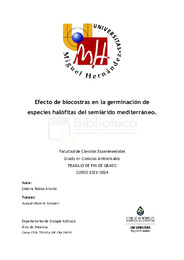Resumen :
Las biocostras son comunidades de organismos como cianobacterias, algas y líquenes
que habitan en el primer centímetro de suelo superficial. En la actualidad, las biocostras
ocupan un 12% del suelo a nivel mundial, apareciendo principalmente en zonas áridas y
semiáridas. Han surgido controversias entre diferentes autores sobre la germinación de
semillas en biocostras, debido a que no se han estudiado tan exhaustivamente estos
organismos y sus efectos. En este contexto, el objetivo de este trabajo es identificar la
composición de la biocostra en ambientes salinos del semiárido mediterráneo y evaluar su
efecto en la germinación de halófitos. Para ello, se recolectaron semillas de cuatro especies
halófilas, así como muestras de biocostra presente en cada una de las zonas a lo largo del
gradiente de salinidad del saladar de Agua Amarga (Alicante). A continuación, se caracterizó
el suelo de la zona de estudio y se identificaron los géneros de las cianobacterias presentes
en la biocostra. Además, se realizó un experimento de germinación considerando las cuatro
especies en tratamientos con y sin biocostra bajo condiciones controladas durante 30 días.
Tras el experimento de germinación se calculó el porcentaje final de germinación y el tiempo
medio de germinación. Los géneros de cianobacterias identificados en la zona de estudio
fueron: Anabaena sp., Aphanocapsa sp., Calothrix sp., Lyngbya sp., Gloeocapsa sp.,
Microcoleus sp., Oscillatoria sp., Phormidium sp. y Pseudanabaena sp. Finalmente, los
resultados del experimento mostraron en general como la biocostra no afectó de forma
positiva a la germinación de los halófitos estudiados. Sin embargo, se observaron diferencias
significativas entre la interacción del tipo de suelo y el tipo de especie vegetal, dependiendo
la germinación en los ambientes salinos más de estos factores que de la presencia/ausencia
de biocostra.
Biocrusts are communities of organisms such as cyanobacteria, algae and lichens that
live in the first centimeter of surface soil. Currently, biocrusts occupy 12% of the soil
worldwide, appearing mainly in arid and semi-arid areas. Controversies have arisen between
different authors about seed germination in biocrusts, because these organisms and their
effects have not been studied so exhaustively. In this context, the objective of this work is
to identify the composition of the biocrust in saline environments of the semiarid
Mediterranean and to evaluate its effect on the germination of halophytes. To do this, seeds
of four halophilic species were collected, as well as samples of biocrust present in each of
the areas along the salinity gradient of the Agua Amarga salt flat (Alicante). Next, the soil
of the study area was characterized and the genera of cyanobacteria present in the biocrust
were identified. In addition, a germination experiment was carried out considering the four
species in treatments with and without biocrust under controlled conditions for 30 days.
After the germination experiment, the final percentage of germination and the average
germination time were calculated. The cyanobacteria genera identified in the study area
were: Anabaena sp., Aphanocapsa sp., Calothrix sp., Lyngbya sp., Gloeocapsa sp.,
Microcoleus sp., Oscillatoria sp., Phormidium sp. and Pseudanabaena sp. Finally, the results
of the experiment generally showed how the biocrust did not positively affect the
germination of the halophytes studied. However, significant differences were observed
between the interaction of soil type and type of plant species, with germination in saline
environments depending more on these factors than on the presence/absence of biocrust.
|
 La licencia se describe como: Atribución-NonComercial-NoDerivada 4.0 Internacional.
La licencia se describe como: Atribución-NonComercial-NoDerivada 4.0 Internacional.
.png)
